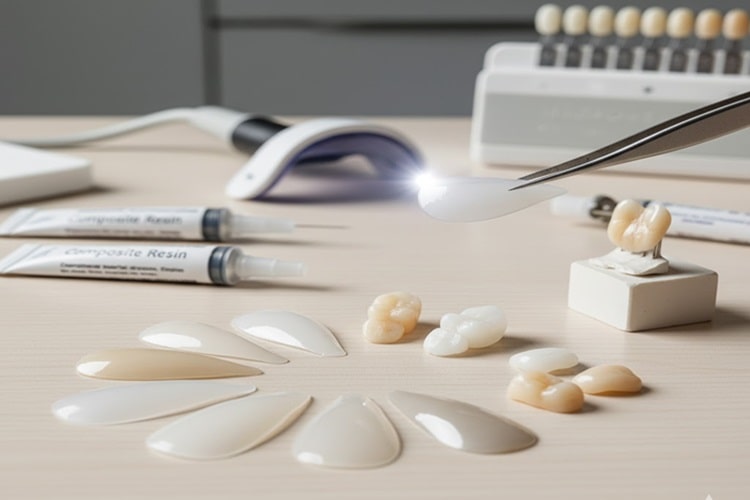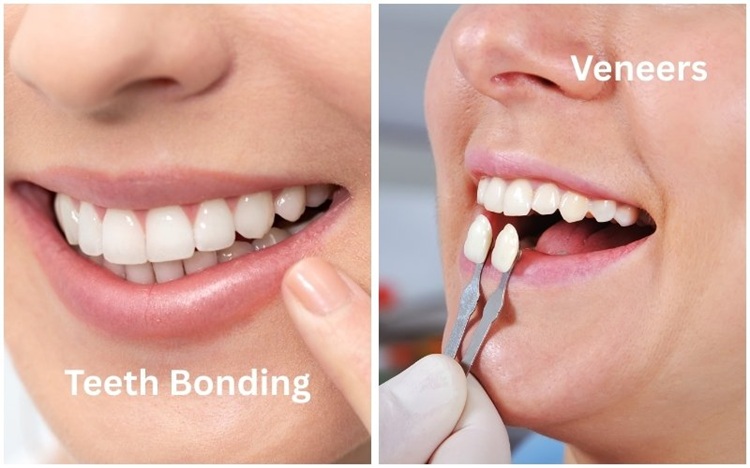A bright smile can totally change the vibe when you walk into a room. If you want a quick way to make your teeth look great, the choice between veneers vs bonding can feel confusing, from material and cost to how long they last and how natural they look. Wondering which one gives you that confident, photo-ready smile without stress? You’re in the right place. Stick around, and by the end, you’ll know which one matches your style, your budget, and your smile goals.

What Are Dental Veneers: Pros and Cons

Dental veneers are thin shells that a dentist places on the front of your teeth to make them look whiter and more even. They hide chips, gaps, or stains and give your smile a clean, polished look fast. Similar results can sometimes be achieved through teeth whitening, depending on the level of discoloration.
Pros:
- Looks very natural and aesthetic
- Long-lasting solution
- Highly stain-resistant
Cons:
- More expensive than bonding
- Irreversible procedure (can’t return to the original teeth)
Read more: “5 real-world dental implant alternatives”
What is Dental Bonding: Pros and Cons

Dental bonding fixes small cracks, chips, or gaps with a tooth-colored resin that a dentist shapes and hardens to match your smile. It’s quick, painless, and great for minor touch-ups.
Pros:
- More affordable than veneers
- Quick procedure (usually one visit)
- Preserves most of your natural tooth
Cons:
- Stains more easily
- Shorter lifespan than veneers
- Can chip or break more easily
Ready to Transform Your Smile?
At My Dentist Langley, we offer personalized consultations to help you decide between veneers, bonding, or other cosmetic treatments for your perfect smile.
Veneers vs Bonding: Key Differences You Should Know
If you’re confused about the veneers vs bonding whole thing, don’t stress out; we covered both options from every perspective to help you choose what truly fits you best.
| Feature | Veneers | Bonding |
| Material | Porcelain or composite thin shells cover the front of teeth. They look shiny and smooth, like real enamel. | Use tooth-colored resin shaped right on your tooth. It blends in well but feels softer and doesn’t shine as much as veneers. |
| Cost | More expensive, usually several hundred to over a thousand dollars per tooth. You pay for a long life and a premium look. | Much cheaper and great for quick fixes. Perfect if you want results without spending too much. |
| Durability & Maintenance | Lasts 10–15 years with good care and resists stains and chips better. | Lasts 4–8 years and may chip or stain faster. Needs more touch-ups over time. |
| Aesthetic Results | Gives a flawless, natural, and reflective finish; perfect for a full smile makeover. | Looks natural but not as shiny. Works best for small corrections or subtle improvements. |
| Time Needed | Usually needs two visits, one for shaping and one for placing. Slightly longer process. | Done in a single visit. Quick and easy for minor repairs or improvements. |
Material

Veneers: they can be porcelain or composite shells that cover the front of your teeth. Porcelain gives a smooth, glass-like finish that looks super natural.
Bonding: Uses a tooth-colored resin that a dentist shapes right on your teeth. It blends well but doesn’t have the same shine or strength as porcelain.
Worried about the effect of dental veneers on your teeth? Check out our article that explains does veneers ruin your teeth or not.
Cost Comparison
Veneers: Their cost can range from several hundred to over a thousand dollars per tooth. You’re paying for durability and a flawless finish. Veneers usually cost more, so be careful about fake dentists offering cheap veneers.
Bonding: Way more budget-friendly. It’s great if you want quick fixes without spending too much, though it might need touch-ups over time
Durability and Maintenance
Veneers: They last about 10-15 years if you take care of them. They handle stains and scratches better than natural enamel, so they stay shiny for a long time. Although there is still a chance that the veneers get whitened.
Bonding: Bonding lasts about 4-8 years. It can chip or stain faster, so you need to be gentle and maybe fix small spots after a few years.
Wondering if veneers are a lifelong fix or if they’ll need replacing later? Read more about: “Are veneers a permanent solution?”
Aesthetic Results and Natural Look
Veneers: Veneers reflect light just like real enamel; they give you that celebrity-style smile. They come custom-made for each tooth, so everything looks smooth and natural.
Bonding: Bonding looks natural, too, but it doesn’t shine as much as veneers. It’s perfect for fixing small flaws but won’t completely transform your smile.
Time Required for Each Procedure
Veneers: Veneers usually need two visits; one to shape your teeth and one to place the final shells. It takes a bit longer, but it’s totally worth it for a big change.
Bonding: Takes just one visit. A dentist applies and polishes the resin in under an hour for each tooth; perfect if you need a fast fix.
Read more: “Can White Fillings Be Whitened and Made to Match Your Teeth?”
Which Option Is Right for Your Smile

The choice between veneers vs bonding really comes down to what you want and how you live. Go for veneers if you want a shiny, perfect smile that lasts for years. Pick bonding if you just need a few small fixes and want to save time and money. Both will make you feel more confident, so think about what matters most before you decide.
Read more: “Does Teeth Whitening Remove a Thin Layer from Your Teeth?”
Take the First Step Toward Your New Smile
Now that you know the difference between veneers vs bonding, it’s time to take the next step toward your dream smile. At Dentist Langley, we give friendly consultations to help you pick the option that works best for you. If you’re concerned about uneven gums or a “gummy” smile, learn more about our gummy smile treatments to complete your perfect look.
FAQ
-
Do veneers look more natural than bonding?
Yes, usually they do. Veneers reflect light almost like real enamel and keep their shine for years. Bonding still looks good, but it doesn’t match the glassy, flawless finish that veneers create.
-
Can I get veneers or bonding on just one tooth?
Absolutely. You can fix one tooth or a few. It depends on what you want to improve. A dentist checks your smile and tells you which option works best for your situation.
-
How long do veneers and bonding last?
Veneers last around 10–15 years when you care for them properly. Bonding lasts about 4–8 years and may need small touch-ups. Regular brushing and avoiding hard foods help both last longer.
-
Can I whiten my teeth after I get veneers or bonding?
You can whiten your natural teeth, but veneers and bonding won’t change color. It works best to whiten your teeth first, then pick a matching shade when you get your dental work done.
-
Which one needs more care, veneers or bonding?
Veneers resist stains and daily wear better than bonding, so they need less upkeep. Still, you should brush twice a day, floss, and avoid biting on hard stuff to keep both options safe.
Have you tried veneers or bonding before? Share your experience or questions in the comments below. We’d love to hear what worked for your smile!




